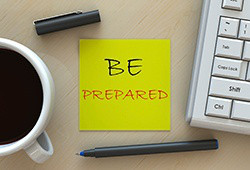 If you ask any business leader what their most valuable asset is, an overwhelming majority would state it’s their people. Businesses invest millions, if not billions, of dollars in training and benefits for their employees. So when it comes to business continuity or disaster preparedness, why wouldn’t an employer want to ensure their employees were also prepared to handle a disaster?
If you ask any business leader what their most valuable asset is, an overwhelming majority would state it’s their people. Businesses invest millions, if not billions, of dollars in training and benefits for their employees. So when it comes to business continuity or disaster preparedness, why wouldn’t an employer want to ensure their employees were also prepared to handle a disaster?
There are two facets of employee preparedness to consider – their personal preparedness and their preparedness as an employee of the business. Disasters come in many forms. They may only strike your business or they may be more widespread, such as severe weather, and cause disruption to your employees’ personal lives as well.
Let’s consider the business perspective first. With regard to larger businesses the statistics vary, but the data consistently reports a range of 70-80% of businesses that fail within 18 months to 3 years following a disaster. According to the American Red Cross/FedEx Small Business Survey, 94% of small businesses feel a disaster could seriously disrupt their company within the next two years. This survey defined small businesses as those with 7-99 employees. Census data from 2013 shows small businesses in that range employed almost 55 million people. While statistics vary on how many business fail to re-open after a disaster, the United States Small Business Administration indicates over 90% of business fail within two years after being struck by a disaster. That means 46.5 million people are at risk for losing their jobs due to disaster striking a small business.
That’s a staggering number. And it is why you must ensure your employees (a) are aware that you have a disaster or business continuity plan and (b) understand how the plan will work if/when disaster strikes. Your employees need to be part of your business continuity plan – from the development and testing, to the regular communication and annual review of your plan.
Many businesses fail to get the right people involved in the development of their plan; focusing on the cyber aspect and therefore assuming it should be an IT responsibility. That may be the right person for your organization, but it may not be. The person leading the plan development should be a strong communicator and facilitator who can handle project management.
As your employees interact with the “champion” who is working to develop the plan, you will gain buy-in that this is everyone’s plan. This is critical to the communication piece. Employees who are confident in the strength of your business continuity plan will be more apt to continue to perform well during the chaos as they will be less concerned that their job is at risk.
The other component of employee preparedness is helping your team understand the importance of personal disaster preparedness. There are many resources available to provide employees to aid in their development of a personal disaster plan. I’d recommend checking out FEMA’s easy-to-complete form which assists individuals in recording key contact people and important family information for easy access and use in case of disaster.
What kind of disasters might your employees experience? The most common are severe weather incidents, natural disasters, and fires. Helping your employees better understand these situations and how they arise is a key component to their personal preparedness.
Do your employees have escape routes from their home and neighborhood? Have they communicated and practiced this with their family members? Do your employees have adequate homeowners or renter’s insurance to cover their personal property in the event of a natural disaster? Do they store and maintain critical documents in a location separate from their home? Do they maintain a home emergency kit?
Your employees are likely your most valued asset and are depending on you to ensure their future. Aiding them in their personal preparedness, as well as informing them as to how prepared you are for a disaster, is the most effective way to get your business back up and running quickly should disaster strike.




